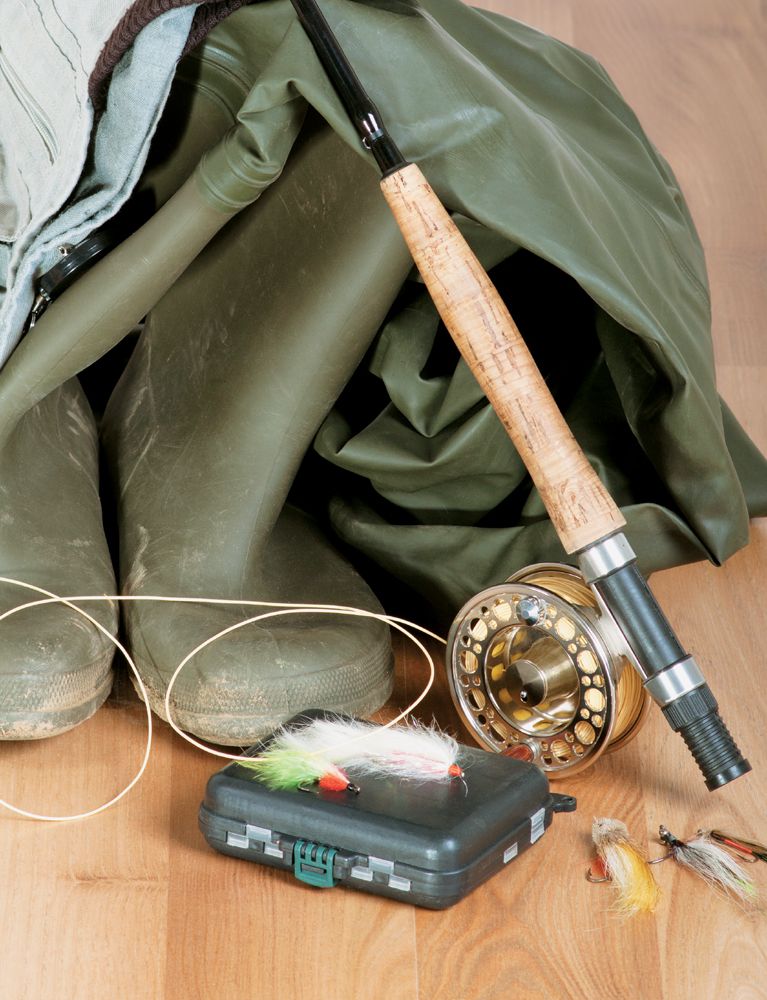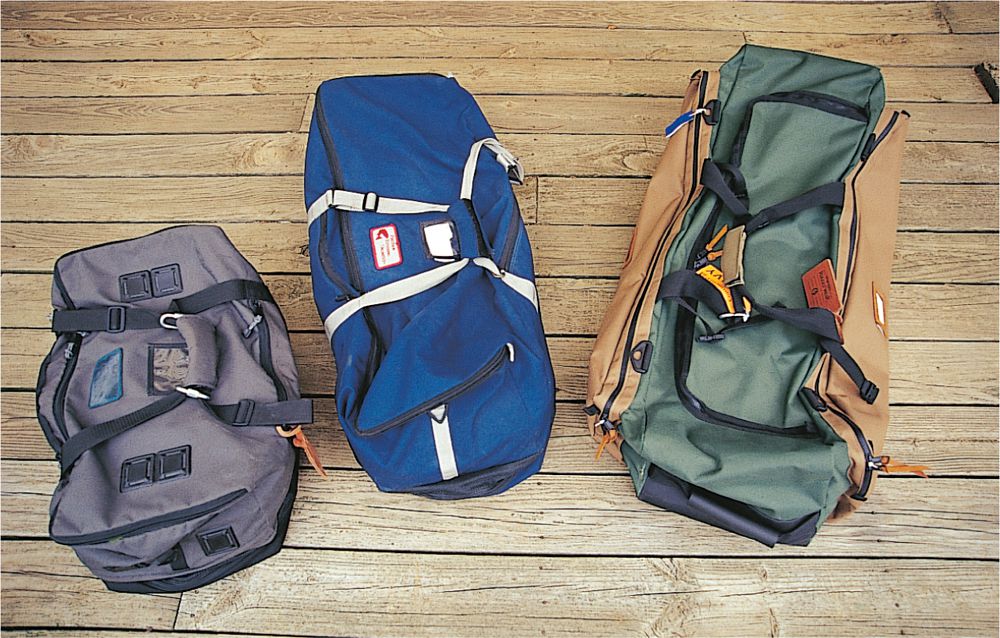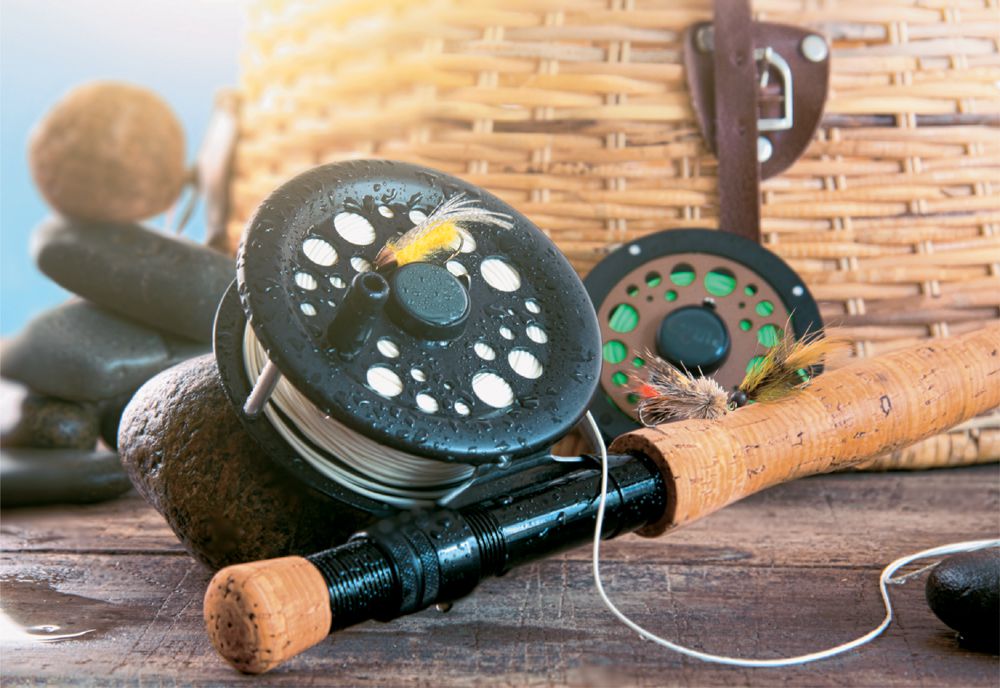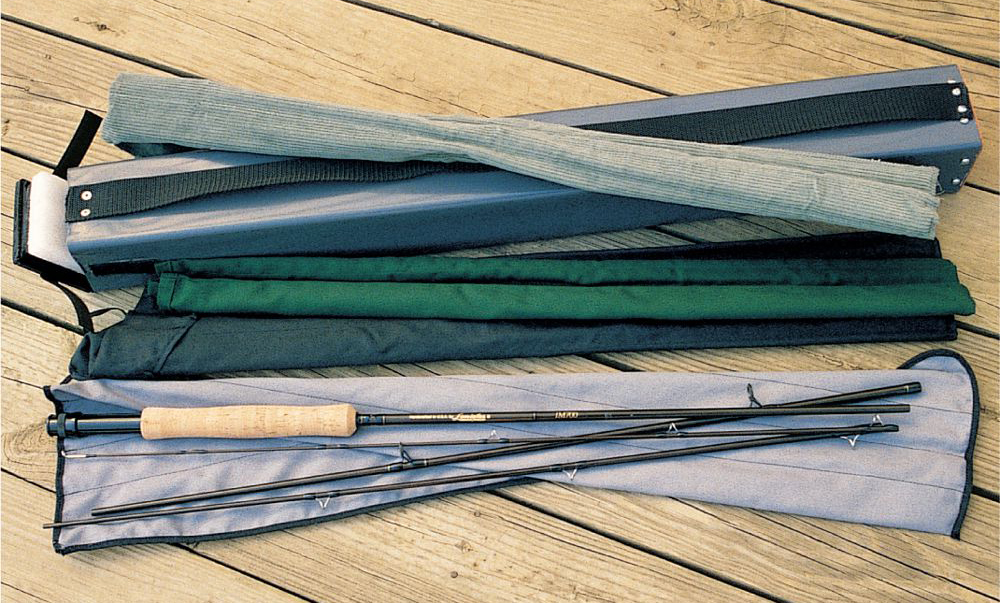


Air travel is becoming increasingly difficult and increasingly confining in the amount of luggage allowed as baggage. For any travel, consider lightweight, travel-style boot-foot waders. They are lighter to carry, less cumbersome to use than the separate stocking-foot and brogue waders, and easier to pack. If fishing in a cold climate, you can insulate them by adding flannel pajama bottoms, long johns, or sweatpants under your pants.


Today manufacturers make many duffle bags long enough to carry travel rods. They have stiff bottoms and rollers so that you can drag them around without damage. These are ideal for travel, since you can pack your travel rods in the case and lessen the possibility of a separate rod case going astray. Just make sure that you have a long enough duffle and that the zipper opening allows you to pack the rods. For 9-foot (2.7-m) four-piece rods, you need an opening to take 29- to 30-inch (73.7- to 76.2-cm) rod cases, and for three-piece rods, you need an opening to take 39- to 40-inch (99.1- to 101.6-cm) rod cases.

Duffle bags are ideal for carrying a lot of fishing gear on trips. Most of them have two strap handles, both of which you have to hold to carry the duffle. Unfortunately, many baggage handlers for airlines, rail, and bus lines (or even your friends unloading a vehicle) might grab just one handle and tear the handle from the heavy bag. To prevent this, buy one or two screw-type chain links, called “quick links” in hardware stores. Use these to attach the two handles. That way, even if a baggage handler grabs only one strap, the two straps can’t separate to tear the bag. These links also make it easy for TSA personnel to remove and open the bag for inspection.


Many anglers, returning to the car after a day of fishing, place their fly rods on top of the car for safe keeping while loading other gear or removing boots or waders. Don’t do it—too often anglers drive off with the rods still on the roof, with obvious disastrous results.
The right way to do this and protect the rods is to lay the rods on top of the car, reel forward, with a long loop of line hanging over the driver’s side of the windshield. That way the rod is protected and you will easily notice the loop of line if you forget to put the rods away. This works with all colors of fly lines, in any background situation.
An alternative method of protecting rods is to carry with you a small square (12 by 12 inches or larger) of rubberized sheeting, such as is used in kitchen cabinets. Place this on the hood of the car, on the driver’s side, and place your assembled rod reel forward, on the mat. Allow the rod to extend over the roof of the car in front of the driver’s side. The rubberized sheet protects both the car hood and the reel finish from damage and also protects against any slipping. The mat sheet rolls up easily and can be stored in a glove compartment of the car.

The best way to travel with rods in a car is to keep them in their rod tubes, storing them carefully in the trunk or on the back seat. If you do not use, or do not have, rod tubes, bundle the rods together and store them on top of other gear so that they are not broken.
If moving while fishing, reel in excess line, break down the rods into two sections, and lay carefully on top of other gear. Many anglers break down rigged two-piece rods into two sections for travel in cars and to carry in boats. Usually these rods are completely rigged down to the fly and ready to cast once reassembled.
Capt. Norm Bartlett came up with a neat way to keep the two sections together to reduce tangles and possible damage. He uses the small spring-type hair clips to hold the rod parts together. He uses two of these, one on each end of the rod (but above the grip). These go on and come off instantly and are easy to use. They are also available in a variety of sizes to fit your individual needs. Get a bright color so they won’t get lost.
Other possibilities are to use a rubber band, plastic bag twist ties, or pipe cleaner to hold the sections and the line together to make it easy to assemble once at a new fishing spot. Another alternative is to use one of the car-top rack systems that are available now.


Even though they are a little more expensive and less readily available than standard two-piece rods, more and more fly anglers are buying their rods in three- or four-piece travel styles. This makes packing and storing rods easier, particularly when traveling by plane to distant fishing locations. If you travel a lot to fish, consider this, or consider adding a stock of travel rods to your tackle inventory.
Often traveling fly anglers find themselves in a variety of different motels or fishing lodges. And sometimes you have to get up at night to go to the bathroom. Carry a small night light in your toiletry kit and plug it into a bathroom socket. To keep from leaving it on the last morning of your trip, write out the word “LIGHT” on a business card and place it on the sink counter. You are sure to see it and grab the light before you leave in the morning.

If going on a long trip or international fishing expedition, consider carrying a field emergency kit. You will need only one for your party. You can customize such a kit for your needs. My kit fits into a six-compartment lure box and contains the following:
 small screwdriver kit;
small screwdriver kit;
 small-handled socket wrench set;
small-handled socket wrench set;
 cigarette lighter;
cigarette lighter;
 spare scissors;
spare scissors;
 small pocket flashlight with fresh batteries;
small pocket flashlight with fresh batteries;
 rubber bands;
rubber bands;
 candle stub (for lubricating rod ferrules, to use as a light, or to start an emergency fire);
candle stub (for lubricating rod ferrules, to use as a light, or to start an emergency fire);
 small wire cutters;
small wire cutters;
 small pocket folding tool kit;
small pocket folding tool kit;
 extension butts for rods;
extension butts for rods;
 nail clipper;
nail clipper;
 spare folding pocketknife;
spare folding pocketknife;
 spare hook hone/file;
spare hook hone/file;
 pipe cleaners (for securing rod sections and cleaning small parts).
pipe cleaners (for securing rod sections and cleaning small parts).
Make up your own field kit as desired, based on your needs and fishing tackle, using the above as a guide. If flying, realize that even with checked baggage, you might have to remove some items, such as the cigarette lighter. Check with the airline first.
With recent terrorist threats and security scares, airport security has gotten much tighter, and it has created challenges for traveling with fly tackle. The simplest solution is to not carry on any fishing tackle. Also, consider the following suggestions:
 Pack all gear in suitcases or duffle bags. Rolling duffle bags are ideal for this, provided that they are the long style that will hold a rod case (or cases) for a 3- or 4-piece 9-foot (2.7-meter) fly rod.
Pack all gear in suitcases or duffle bags. Rolling duffle bags are ideal for this, provided that they are the long style that will hold a rod case (or cases) for a 3- or 4-piece 9-foot (2.7-meter) fly rod.
 Pack reels in padded reel bags.
Pack reels in padded reel bags.
 If you do not have protective reel bags, use a thick sock or layer of underwear.
If you do not have protective reel bags, use a thick sock or layer of underwear.
 Layer fly boxes and other accessories so that they are padded by clothing.
Layer fly boxes and other accessories so that they are padded by clothing.
 Fold travel waders, boot-foot-style or stocking-style (your choice), and place them at one end of the duffle bag for extra padding and protection.
Fold travel waders, boot-foot-style or stocking-style (your choice), and place them at one end of the duffle bag for extra padding and protection.
 Empty your fishing vest to make it simpler and less bulky to pack, and store at the other end of the duffle bag.
Empty your fishing vest to make it simpler and less bulky to pack, and store at the other end of the duffle bag.
 Store items such as fishing knives, pliers, hook hones, disgorgers, hemostats, gaffs, thermometers, screwdrivers, wading staffs, etc., in one place or preferably in one bag or container so that inspecting federal Transportation Security Administration (TSA) security agents can find these items.
Store items such as fishing knives, pliers, hook hones, disgorgers, hemostats, gaffs, thermometers, screwdrivers, wading staffs, etc., in one place or preferably in one bag or container so that inspecting federal Transportation Security Administration (TSA) security agents can find these items.
 Similarly, keep all fly boxes in one area so that agents can find and check the hook contents of the boxes.
Similarly, keep all fly boxes in one area so that agents can find and check the hook contents of the boxes.
 Store all liquids, such as fly floatants, leader sinks, insect lotions and sprays, sunscreen, etc., in two (one inside the other) zipper-seal plastic bags for safekeeping. Use sealed bags to prevent damage to luggage contents should one of the items leak.
Store all liquids, such as fly floatants, leader sinks, insect lotions and sprays, sunscreen, etc., in two (one inside the other) zipper-seal plastic bags for safekeeping. Use sealed bags to prevent damage to luggage contents should one of the items leak.

If you buy products outside of the country, you may only bring back a certain dollar value before officials charge a tariff. Since many cameras, video cameras, laptops, electronics, and even some fishing tackle is made in other countries, it pays to get Customs slips of all this equipment before leaving the country. Take all your foreign-made equipment to the nearest Customs office and fill out the paperwork for each piece of equipment.
Each slip requires that you supply your name, address, and the name and serial number of each piece of equipment. Usually, you can list up to about six pieces of equipment on each slip, depending upon how large you write. The Customs officers on duty will check the serial numbers on your slip against your equipment, and then mark each slip with an official Customs stamp. The good news is that once you do this, these slips are good for life. Just be sure to take all of them with you on any trip out of the country.
If traveling to a foreign country, make one or two photocopies of your passport. That way, should your passport get lost or stolen you will at least have a copy of the front page with the passport number and other vital information for getting a new passport or help from embassies, Customs offices, or US consulate offices. Make sure that you keep all such copies safely secured, and in a different location than the location of your passport. Realize that this could change with Homeland Security regulations, so check first, and if not allowed for any reason, at least write down your passport number.
If you are traveling, consider minimizing the number of credit cards that you carry to prevent problems should they be lost or stolen. Also, make a photocopy of all credit cards that you carry, making sure that the credit card numbers are visible. In addition, write down on this copy the US or international phone numbers for reporting lost or stolen credit cards to the credit card company to prevent fraudulent use. Be sure that you keep this list separate from your wallet, but in a safe place where thieves will not find it. In addition, consider photocopying any other cards that you might need while on your trip. Possibilities include health insurance cards, car registration, voter’s registration cards, visas, etc.
If two or more of you are going on a fly fishing trip together, make it easy by pooling common expenses, such as tolls, gas, tips, shared motel rooms, and even meals if the meals for each are about the same cost. Appoint one person “treasurer” to pay all common expenses. Then each person adds to a kitty a set amount for paying these expenses. When the fund is low, each person adds more money to rebuild it. After the trip is over, redistribute the excess money to all. A nice touch, if traveling by car, is to leave in some extra money for the vehicle owner for an oil change, car wash, etc. Keep all the money and receipts for expenses in a bag. A child’s zippered pencil case or similar sturdy bag is ideal for this.